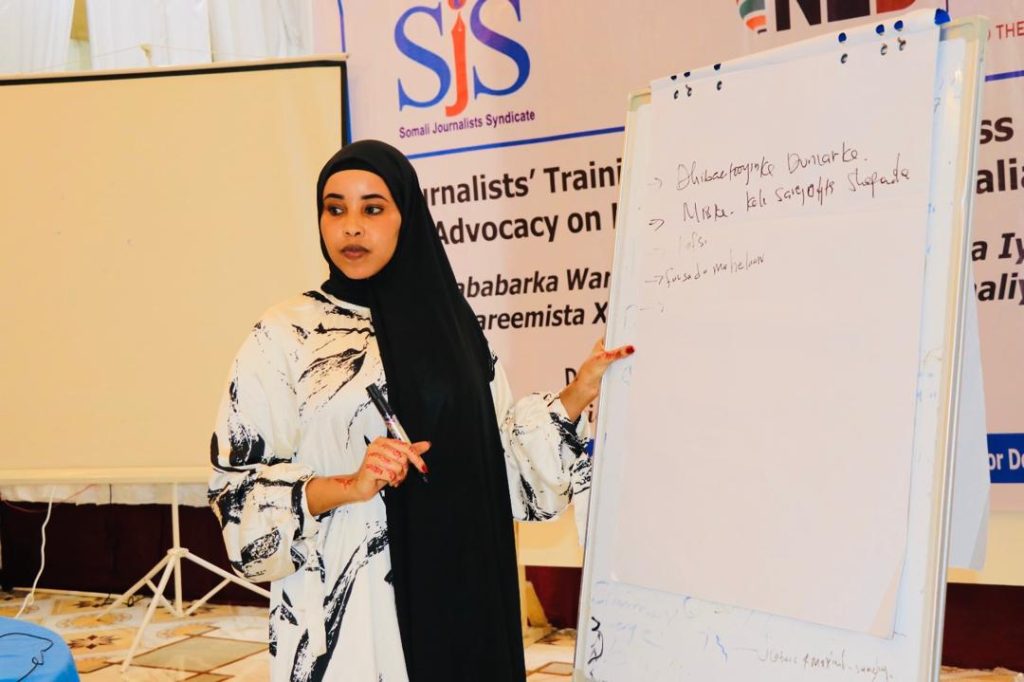
When Anfac Adam Abdi first walked into Goobjoog Media Group in 2018 as a journalism trainee, she had no idea she would one day rise to lead a major television station. “I started as a trainee at Goobjoog TV and Radio,” she recalls. “After three months, I became a newscaster and reporter. At the same time, I was pursuing my university studies.”
Her journey since then has been one of resilience and ambition. By the end of 2021, she joined M24 TV, and in mid-2022, moved to RTN, where she has worked across stations in Mogadishu and Nairobi. Today, she serves as the Director of RTN TV. “It wasn’t easy to reach this point,” she admits. “In our media industry, it’s rare for a woman to hold leadership positions. But I got here through hard work, determination, and vision.”
A Leader Beyond the Newsroom
Before becoming RTN’s Director, Anfac also served the wider journalism community. She is an active member of the Somali Women Journalists Organization (SWJO) and worked with the Somali Journalists Syndicate as a Gender Specialist in 2021. She continues to collaborate with them as a trainer on gender issues, helping young journalists understand gender equality in media practice.

On Gender Policies and Media Environment
Asked about RTN’s commitment to gender inclusivity and whether the station has signed the Gender Declaration for Responsible Media (GDR)—SWJO’s 23-point charter for gender-balanced content, maternity leave, and safe workplaces—Anfac explains:
“Although we are a small station with only two female journalists, we’ve tried to create a safe and respectful environment. My office even doubles as a prayer space when needed. We don’t yet have a written gender policy, but I’m planning to develop one soon. From my time at Goobjoog to now at RTN, I’ve seen how SWJO’s GDR has inspired change.”
The Struggle for Women’s Representation
Women remain underrepresented in Somali media houses—many with only one or two female journalists on staff. Anfac sees this as a structural issue rooted in social perceptions and past abuses.
“It’s always been my plan to bring talented female journalists on board to show that women can do the job just as well—if not better—than men,” she says. “The reason women are few in media is because society still sees journalism as a man’s profession. And unfortunately, some women who joined were mistreated or discouraged by men in power. Many left journalism altogether for other careers. We have to change that.”
Reforming Media Practices
On labor rights and workplace standards, Anfac acknowledges that RTN—like many Somali outlets—still operates without formal contracts. “For now, we don’t have written agreements,” she admits. “But the first thing on my desk this month is to ensure all our employees have signed contracts. I’m working closely with my team to make that happen.”
Creating Space for Women to Compete
Through her leadership, Anfac is also working to ensure women have equal opportunities to work in the field and produce original stories—not just read the news.
“I always encourage my female colleagues to be competitive,” she says. “Many are shy because of their background, or because they’ve internalized the idea that certain roles—like doing vox pops or field reporting—are for men. But this mindset is changing. We now see more women challenging the status quo, and I want RTN to be part of that shift.”
On the Gender Tracking Tool
Anfac has also used SWJO’s Gender Content Tracking Tool, which measures the balance of female and male voices in media coverage.
“It’s a wonderful tool,” she says. “My team and I tried it, and even though we’re short-staffed, I see how valuable it is for promoting women’s visibility in media. We plan to use it more regularly.”
Acting for Awareness
Beyond the newsroom, Anfac has also taken her advocacy to the screen. She starred in a TV drama highlighting sexual harassment by media directors against female journalists—a subject few dare to touch publicly.
“The reaction was mixed,” she says with a smile. “Some women said I embarrassed them and that it wasn’t true. But most thanked me, saying I represented their experiences. As for the men—many were uncomfortable. They said such stories make them afraid to help women. But that’s exactly why we need to keep talking about it.”
Looking Ahead
For Anfac Adam, leadership in media is not just about holding a title—it’s about opening doors for others. “I want to create a newsroom where women feel safe, respected, and empowered to lead,” she says. “Change takes time, but it starts with us.”
